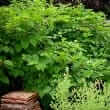Background
- Japanese knotweed (Polygonum cuspidatum), a perennial herb native to Japan, China and Korea, was imported into Great Britain and the United States in the 1800s as an ornamental plant. The shoots, leaves, and stems are edible, but contain oxalic acid, a chemical that may hinder calcium absorption. The three Latin names of Japanese knotweed are used in different regions of the world: Reynoutria japonica in much of Europe; Polygonum cuspidatum, in North America; and Fallopia japonica, in Britain.
- Japanese knotweed is a common commercial source of resveratrol, a chemical well-known for its presence in red wine. Resveratrol, which is available as a dietary supplement, has reported antiaging, antioxidant, anti-inflammatory, anticancer, and lipid-lowering effects.
- Traditional medicinal uses of Japanese knotweed root extracts include improvement of oral hygiene and cardiovascular health and treatment of acute hepatitis, high cholesterol, inflammation, skin rash, and constipation.
References
Natural Standard developed the above evidence-based information based on a thorough systematic review of the available scientific articles. For comprehensive information about alternative and complementary therapies on the professional level, go to . Selected references are listed below.
- Bagchi D, Das DK, Tosaki A, et al. Benefits of resveratrol in women's health. Drugs Exp.Clin Res 2001;27(5-6):233-248.
View Abstract - Bralley EE, Greenspan P, Hargrove JL, et al. Topical anti-inflammatory activity of Polygonum cuspidatum extract in the TPA model of mouse ear inflammation. J Inflamm.(Lond) 2008;5:1.
View Abstract - Chang JS, Liu HW, Wang KC, et al. Ethanol extract of Polygonum cuspidatum inhibits hepatitis B virus in a stable HBV-producing cell line. Antiviral Res 2005;66(1):29-34.
View Abstract - Feng L, Zhang LF, Yan T, et al. [Studies on active substance of anticancer effect in Polygonum cuspidatum]. Zhong.Yao Cai. 2006;29(7):689-691.
View Abstract - Hsu CY, Chan YP, Chang J. Antioxidant activity of extract from Polygonum cuspidatum. Biol.Res 2007;40(1):13-21.
View Abstract - Kim KW, Ha KT, Park CS, et al. Polygonum cuspidatum, compared with baicalin and berberine, inhibits inducible nitric oxide synthase and cyclooxygenase-2 gene expressions in RAW 264.7 macrophages. Vascul.Pharmacol 2007;47(2-3):99-107.
View Abstract - Leu YL, Hwang TL, Hu JW, et al. Anthraquinones from Polygonum cuspidatum as tyrosinase inhibitors for dermal use. Phytother.Res 2008;22(4):552-556.
View Abstract - Lim BO, Lee JH, Ko NY, et al. Polygoni cuspidati radix inhibits the activation of Syk kinase in mast cells for antiallergic activity. Exp.Biol.Med (Maywood.) 2007;232(11):1425-1431.
View Abstract - Park, CS, Lee, YC, Kim, JD, et al. Inhibitory effects of Polygonum cuspidatum water extract (PCWE) and its component resveratrol [correction of rasveratrol] on acyl-coenzyme A-cholesterol acyltransferase activity for cholesteryl ester synthesis in HepG2 cells. Vascul.Pharmacol. 2004;40(6):279-284.
View Abstract - Qu, Y, Wang, JB, Li, HF, et al. [Study on relationship of laxative potency and anthraquinones content traditional Chinese drugs]. Zhongguo Zhong.Yao Za Zhi. 2008;33(7):806-808.
View Abstract - Song, JH, Kim, SK, Chang, KW, et al. In vitro inhibitory effects of Polygonum cuspidatum on bacterial viability and virulence factors of Streptococcus mutans and Streptococcus sobrinus. Arch Oral Biol. 2006;51(12):1131-1140.
View Abstract - Wang C, Zhang D, Ma H, et al. Neuroprotective effects of emodin-8-O-beta-D-glucoside in vivo and in vitro. Eur.J Pharmacol 12-22-2007;577(1-3):58-63.
View Abstract - Wang D, Xu Y, Liu W. Tissue distribution and excretion of resveratrol in rat after oral administration of Polygonum cuspidatum extract (PCE). Phytomedicine. 2008;15(10):859-866.
View Abstract - Xing WW, Wu JZ, Jia M, et al. Effects of polydatin from Polygonum cuspidatum on lipid profile in hyperlipidemic rabbits. Biomed.Pharmacother. 2009;63(7):457-462.
View Abstract - Zhang CZ, Wang SX, Zhang Y, et al. In vitro estrogenic activities of Chinese medicinal plants traditionally used for the management of menopausal symptoms. J Ethnopharmacol. 4-26-2005;98(3):295-300.
View Abstract







